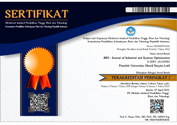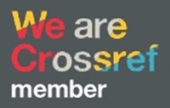PENGUKURAN BEBAN KERJA KARYAWAN FROZEN FOOD MENGGUNAKAN METODE NASA-TLX
DOI:
https://doi.org/10.51804/jiso.v6i1.25-32Keywords:
frozen food, mental workload, NASA – TLXAbstract
Tujuan penelitian ini adalah mengukur beban kerja karyawan pada lini produksi PT.X di Driyorejo. Terdapat sejumlah karyawan pada masing-masing bagian, yaitu 2 orang pada bagian Penggilingan, 2 orang di bagian Packing, 2 orang di bagian Perebusan, serta 2 orang di bagian Pemotongan Bahan. Pengukuran beban kerja ini menggunakan metode NASA-TLX (National Aeronautics and Space Administration Task Load Index). Dalam metode ini terdapat dua tahap pengukuran, yaitu tahap pembobotan dan tahap pemberian rating. Dalam perhitungan tersebut mengacu pada 6 indikator NASA TLX, yaitu KF, KM, KW, P, TU, serta TF. Hasil dari pengukuran beban kerja mental karyawan menunjukkan bahwa indikator TU (Tingkat Usaha) memiliki nilai yang tertinggi daripada indikator lainnya. Sedangkan indikator TF (Tingkat Frustasi) menjadi yang terendah diantara indikator lainnya. Dan hasil akhir dari perhitungan nilai skor beban kerja mental karyawan PT. X skor NASA-TLX rata-ratanya ialah sebesar 79,25. Artinya untuk nilai ini menurut NASA – TLX termasuk pada kategori beban kerja mental yang berat. Adapun bagian pekerjaan dengan tingkat beban kerja tinggi ada pada bagian Packing dan Penggilingan, tingkat beban kerjanya yaitu sebesar 82,666 di bagian Packing dan 80,666 pada bagian Penggilingan.
ABSTRACT
The purpose of this study is to measure the workload of employees on the PT.X DRIYOREJO production line. Each of which is 2 in the Milling section, 2 in the Packing section, 2 in the Boiling section and 2 in the Material Cutting section. Measurements were made using the NASA-TLX (National Aeronautics and Space Administration Task Load Index) method. In this method there are two stages of measurement, namely the weighting stage and the rating stage. The calculation will refer to 6 NASA TLX indicators, namely KF (Physical Demands), KM (Mental Demands), KW (Temporal Demands), P (Performance), TU (Efforts), TF (Frustration). The results of measuring the mental workload of employees show that the TU (Business Level) indicator has the highest value than other indicators. Meanwhile, the TF (Frustration Level) indicator is the lowest among other indicators. And the final result of calculating the mental workload of employees, the average NASA-TLX score is 79.25. This means that the category of mental workload of employees according to the NASA – TLX method is included in the category of heavy mental workload. The work section with a high level of workload is in the Packing and Milling section, the workload level is 82,666 in the Packing section and 80,666 in the Milling section.
References
Adriansyah, G., & Nizar, N. (2018). Analisa Beban Kerja Kegiatan Administrasi Sekolah Dengan Pendekatan Job Mapping. Teknika: Engineering and Sains Journal, 2(1), 59–66. https://doi.org/10.51804/tesj.v2i1.233.59-6
Anshori, Moch., Retnowati, D., Fudhla, A. F., Adriansyah, G., Ardhyani, I. W., Puspita, A. D., Muafa, A., & Santoso, G. (2021). Usaha Mikro Kecil Dan Menengah Pembuatan Frozen Food Di UKM Raniah, Kebraon, Surabaya, Jawa Timur. Among : Jurnal Pengabdian Masyarakat, 3(2), 1. https://doi.org/10.51804/ajpm.v3i2.1554
Astuty, M. S., W., C. S., & Yuniar. (2013). Tingkat Beban Kerja Mental Masinis Berdasarkan NASA-TLX (Task Load Index) Di PT. KAI Daop. II Bandung. Jurnal Online Institut Teknologi Nasional Reka Integra ISSN: 2338-5081, 1(1), 69–77.
Hendrawan, H. (2013). Pengukuran Beban Kerja Operator Call Center PT. X (Third Party Administrator) Untuk Menentukan Jumlah Operator Call Center Optimal. Institut Teknologi Sepuluh Nopember.
Putri, U. L., & Handayani, N. U. (2019). Analisis Beban Kerja Mental Dengan Metode Nasa Tlx Pada Departemen Logistik Pt Abc. Jurnal Teknik Industri, 6(2), 1–10.
Sari, R. I. P. (2017). Pengukuran Beban Kerja Karyawan Menggunakan Metode NASA-TLX Di PT. Tranka Kabel. Sosio-E-Kons, 9(3), 223–231.
Simanjuntak, R. A. (2010). Analisis Beban Kerja Mental Dengan Metoda Nasa-Task Load Index. Jurnal Teknologi Technoscientia, 3(1), 78–86.
Widyanti, A., Johnson, A., & Waard, D. de. (2010). Pengukuran beban kerja mental dalam searching task dengan metode rating scale mental effort (RSME). J@ Ti Undip, 1, 1–6.
Downloads
Published
Issue
Section
License
With the receipt of the article by JISO Editorial Board and the decision to be published, the copyright regarding the article will be transferred to JISO. The copyright transfer form can be downloaded here.
JISO has the right to multiply and distribute the article and every author is not allowed to publish the same article that was published in this journal.
JISO is licensed under a Creative Commons Attribution-ShareAlike 4.0 International License.
Under the following terms:
Attribution — You must give appropriate credit, provide a link to the license, and indicate if changes were made. You may do so in any reasonable manner, but not in any way that suggests the licensor endorses you or your use.
ShareAlike — If you remix, transform, or build upon the material, you must distribute your contributions under the same license as the original.














